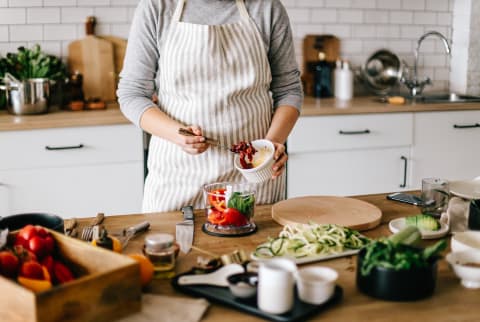Advertisement

Dana Cowin, Editor-in-Chief at Food & Wine magazine since 1995, has been keeping a dark secret — she ruins nearly every single dish she attempts to make. For someone so established in the food world, this is both shocking and, in a way, heartwarming. With the help of her friends, many of them world class chefs, she took on the challenge of finally learning how to properly make 100 recipes she holds dear, which she chronicles her book, Mastering My Mistakes In The Kitchen. Today, Dana tells us the five most important things she's learned from mastering her mistakes.
5 Mistakes Keeping You From Becoming A Great Cook
1. Lack of focus.
The single most important thing in cooking is not perfect technique or ingredients; it's focusing on the task at hand. Distractions doom good food prep. I learned this when I was in the kitchen with fish genius, chef Eric Ripert of Le Bernardin. I was trying, for the first time, to kill a live lobster the humane way, by severing its spinal cord. [See recipe below.] The knife was huge. The lobster shell seemed impenetrable. The photographer was capturing it all. And so was a videographer. After I succeeded, I told Eric I found killing the lobster to be quite challenging. He looked at me, and said kindly, "No. It isn't hard, you just were not focused. Your mind was everywhere but the tip of the knife."
2. Moving too fast.
Rushing is the enemy of flavor. I am often in a hurry when I'm making a meal. I want to get my kids fed before they decide it would be easier to just eat yogurt or plain pasta for dinner. But, as I discovered when I cooked with Kristen Kish, a winner of Top Chef, sometimes you have to slow down to get the most out of your ingredients. I was browning chicken legs that were destined for a stew and I didn't exactly see the point of getting that golden color before they were submerged in liquid. But Kristen insisted, again and again, that we get the proper caramelization on the skin, that I pick up the chicken and sear the sides before continuing with the next step. I rolled my eyes--really? Sear the sides? But in the end, the stew had a deep, rich nuanced taste for this (actually small) amount of extra work.
3. Reading the recipe one step at a time.
A recipe is like a short story, to understand it, you need to read it through to the end, not just as you go. If you don't read all the way to the last step, you can miss some very important plot twists like requiring a piece of equipment you don't have to finish the dish.
4. Forgetting the clock.
Wrong timing ruins great dishes. There are so many ways that poor timing can trip you up — either leading you to burn something or to undercook. Once when I was making a Korean meatloaf for a potluck, I misread how long it had to bake in the oven. And I didn't have enough time to finish it at home, so I brought a half-baked meatloaf with me and finished it in my friend's oven.
5. Ignoring instructions.
Thinking you can outsmart the recipe may lead to failure. Sometimes a chef's instruction will tell me to take an extra step or extra time that seems unnecessary, but I regret this when the results are less than perfect. When a chicken recipe from chef Thomas Keller of The French Laundry in Napa Valley instructs you to let the bird rest for 15 minutes to half an hour before serving, it isn't just a suggestion. It's a critical part of the preparation time that allows the temperature to even out. And, as Keller says, "Letting the chicken rest also creates anticipation — the aromas are there and everyone wants to know, 'when are we going to eat.'"
Pan-Roasted Lobster with Red Miso + Citrus Sauce
There is a lot of lobster history in my family. My cooking-adverse mother adores lobster, and surprisingly, even tried to prepare it once or twice. As one story goes, she brought home a bag of the crustaceans and a few got loose and ended up under the radiator; I'm not sure they were ever found. But what I remember best is the time my mother bought lobsters and elected me to put them in the boiling water. I gingerly picked up one specimen and put it in the pot tail first. What came next was not a pretty sight, as its claws desperately stabbed the air above the edge of the pot. I ran out one door and my mother ran out the other; we returned only when the lobster was no longer visible.
When I told seafood genius Eric Ripert of Le Bernardin in New York City that tale recently, he teased me that there would be karmic retribution: I would come back as a lobster in my next life. Eric explained that the most humane way to kill a lobster is to take a sharp knife and sever the spinal cord. The key is first stroking the head of the lobster so that it's calm and not wiggling around, then stabbing it decisively. I tried several times before succeeding. Though I learned how to kill a lobster, I took away an even bigger lesson: the importance of focus. If my mind had been trained on the lobster and only the lobster in that critical moment, I am convinced I would have succeeded with the first cut.
Eric's recipe for pan sautéing lobster here involves much concentration, tenacity and finesse. It is also not for the squeamish! After its swift death, the lobster will keep moving, the tail especially. If all this sounds very daunting, I have a simple solution: substitute shrimp for the lobster and just make the incredibly delicious sauce to serve on top.
Pan-Roasted Lobster with Red Miso + Citrus Sauce
Total Time: 45 minutes
Serves 2
- 2 small live lobsters (about 11⁄4 pounds each)
- 3 tablespoons vegetable oil
- Kosher salt and freshly ground black pepper
- Red Miso + Citrus Sauce (recipe follows)
1. Bring a large saucepan of water to a boil over high heat.
2. Meanwhile, place one lobster on a large cutting board and gently rub the top of its head to calm it. Splay its claws, so the head is flat against the board. Hold down the body. Jab a heavy, sharp chef 's knife into the head between the eyes, then pull the knife down, as if pulling down a handle, straight through the head. Make sure you have a good grip on your knife by choking up on the handle, and work confidently and swiftly. (The lobster will continue to move but it is no longer alive.)
3. Tuck the tail under the body so you can grab the whole thing in your hand to twist the head off. Lay the lobster tail upside down on the cutting board and cut it lengthwise in half through the softer shell. Then crack it open (almost like opening a book). Remove and discard the intestinal vein that runs down the tail. Repeat with the remaining lobster and refrigerate the lobster tails.
4. Twist off the claws; they should come off easily. Remove the rubber bands. Put the claws in the saucepan of boiling water and cook for 5 minutes, then transfer to a plate to cool.
5. Working with a kitchen towel to protect your hands from the sharp claws, twist the knuckles off the claws. One at a time, place each claw upright on the board, the claw facing the ceiling. Hold the whole claw upright, then tap it against the board to release the meat from the shell.
Open the pinchers of the claw and, holding on to the large pincher, give it one authoritative whack between the little spikes of the pinchers with your knife to crack it, then twist the knife gently left and then right to get it out. This will crack the claw in a way that allows you to easily twist the shell and remove the claw in one piece. Use your knife blade to pull the thin layer of white protein away from the surface of the claw and remove the thin cartilage inside of the claw.
6. For the knuckles, lay each one on a kitchen towel, hold it down with one hand and use scissors to cut through the shell. Lay it on the board and use both hands to open the shell if it proves difficult. Use your fingers to remove the meat. Set the claw and knuckle meat aside.
7. Reserve the lobster shells for stock or discard them.
8. Heat the vegetable oil in a large heavy skillet over high heat. Meanwhile, season the lobster tails with salt and pepper. When the oil is shimmering, place the lobster tails flesh side down in the pan, pressing down if they curl up. Once the underside takes on some color, about a minute or two, carefully flip the tails over and cook until the shells turn bright red and even get slightly charred in spots, another minute or so. Transfer the tails to a cutting board. Put the claw and knuckle meat in the pan, turn off the heat and turn the claws and knuckle once just to warm them on both sides.
9. Meanwhile, insert a fork into the meat in each lobster tail and pull each half out of the shell in one piece. Place the meat back in the pan with the claws and knuckles to warm. (Reserve the shells for stock if you'd like.)
10. Transfer the lobster meat to a paper towel to absorb any excess oil and then arrange on plates. Spoon the sauce around the lobster and serve immediately.
Red Miso + Citrus Sauce
Total Time: 20 minutes
Makes ½ cup
- 1 teaspoon minced shallot
- 1 teaspoon minced peeled ginger
- 1 cup freshly squeezed orange juice
- 1 teaspoon red miso, or to taste
- 1 tablespoon freshly squeezed lemon juice, or to taste
- 1 tablespoon freshly squeezed lime juice, or to taste
- 3 tablespoons extra-virgin olive oil
- Kosher salt
1. Put the shallot, ginger and orange juice in a small saucepan over high heat and bring to a boil. Whisk in the miso, turn the heat down to medium-high and boil until the mixture is reduced by half, about 5 minutes.
2. Whisk in the lemon and lime juices and then, whisking vigorously, slowly drizzle in the olive oil until the sauce is thickened and emulsified. Season with salt.
MAKE AHEAD
The sauce can be refrigerated for up to 3 days. Rewarm over low heat and season with additional citrus juice or salt if needed.
Chef Tips from Eric Ripert:
ON SHOPPING FOR LOBSTER
Turn the lobster upside down and make sure the underside of the tail, toward the head, is firm and plump. This indicates a fresh, healthy lobster.
ON THE BEST WAY TO KILL A LOBSTER
Cutting the spinal cord is the quickest, most humane way. Boiling is a slow process! Start by rubbing the top of the lobster's head to calm it.
ON LOBSTER ANATOMY
Long antennae mean the lobster is fresh from the ocean; short ones mean it was kept in a tank. Female lobsters have "hairy legs," and their meat is pinker than the meat of the males. Note the difference between the two parts of the claws—almost like a knife and fork—one is much sharper than the other. One is used for cutting things, the other for grabbing.
ON WHISKING
When you whisk a sauce, you must be in control of your whisk. There are three ways of whisking: vigorously side to side (which you want here); making a figure eight; or, when whipping cream in a bowl, making big sweeping motions to incorporate as much air as possible.
ON MAKING A SMOOTH SAUCE
For the sauce to emulsify. one liquid (here the citrus juice mixture) must to be boiling and the other (the oil) must not be hot. With the citrus mixture at a boil, whisking continuously, very slowly drizzle in the olive oil until emulsified. Taste for seasoning, adding a bit more salt, lemon, lime or miso if you feel it needs it. The sauce should have lovely, thick volume.
ON FIXING A BROKEN SAUCE
Heat it back up and whisk in more olive oil. Temperature changes can cause a sauce to break.
ON PLATING THE LOBSTER
First transfer the warm meat to a paper towel to absorb any excess oil. Then transfer to the plates. Give the sauce a final whisk and spoon it, choking up on the spoon so you have more control, onto the plates, around but not on top of the lobster. That way, whoever is eating can determine how much sauce is on each piece.
Excerpted From Mastering My Mistakes in the Kitchen by Dana Cowin. Copyright 2014 Dana Cowin. Excerpted by permission of Ecco, an imprint of HarperCollins Publishers.
Watch Next
Enjoy some of our favorite clips from classes
Enjoy some of our favorite clips from classes
What Is Meditation?
Mindfulness/Spirituality | Light Watkins
Box Breathing
Mindfulness/Spirituality | Gwen Dittmar
What Breathwork Can Address
Mindfulness/Spirituality | Gwen Dittmar
The 8 Limbs of Yoga - What is Asana?
Yoga | Caley Alyssa
Two Standing Postures to Open Up Tight Hips
Yoga | Caley Alyssa
How Plants Can Optimize Athletic Performance
Nutrition | Rich Roll
What to Eat Before a Workout
Nutrition | Rich Roll
How Ayurveda Helps Us Navigate Modern Life
Nutrition | Sahara Rose
Messages About Love & Relationships
Love & Relationships | Esther Perel
Love Languages
Love & Relationships | Esther Perel


















